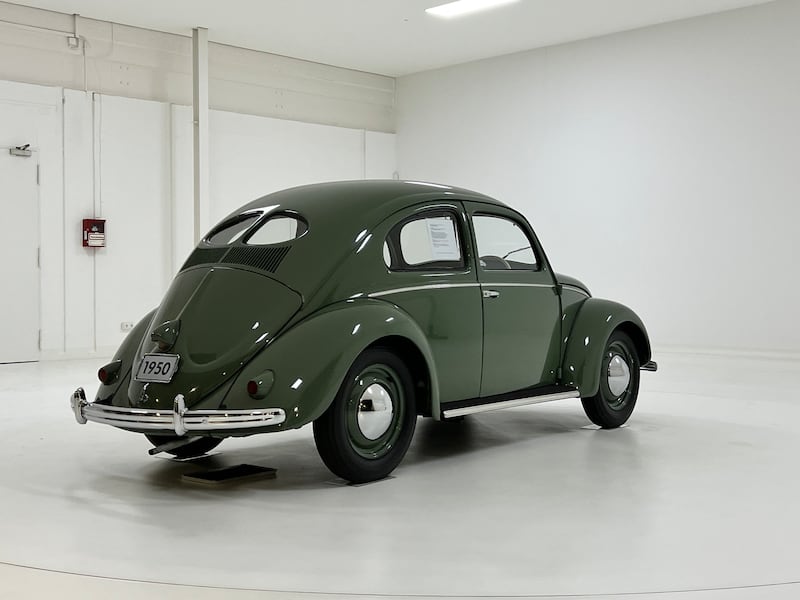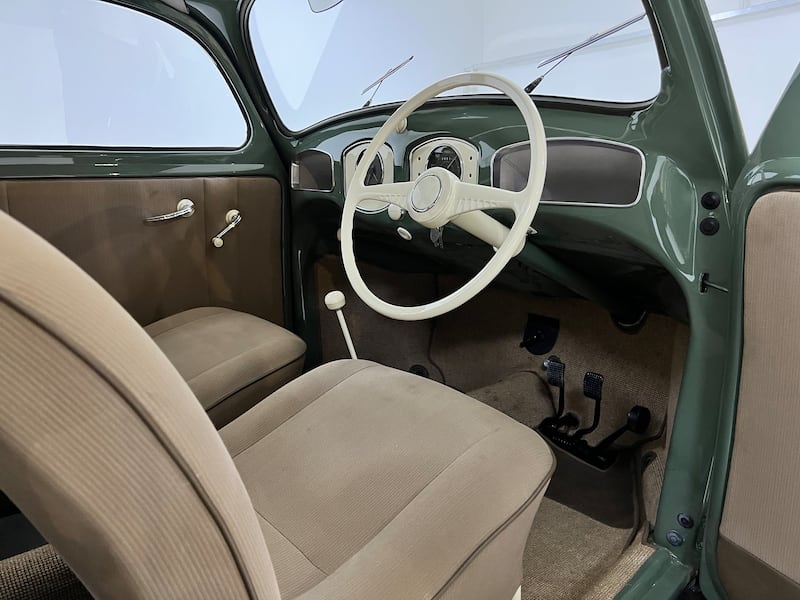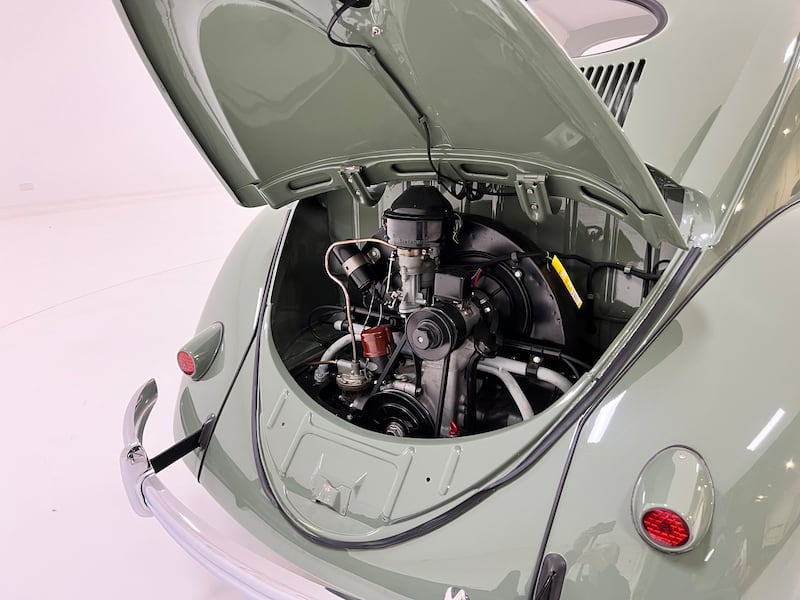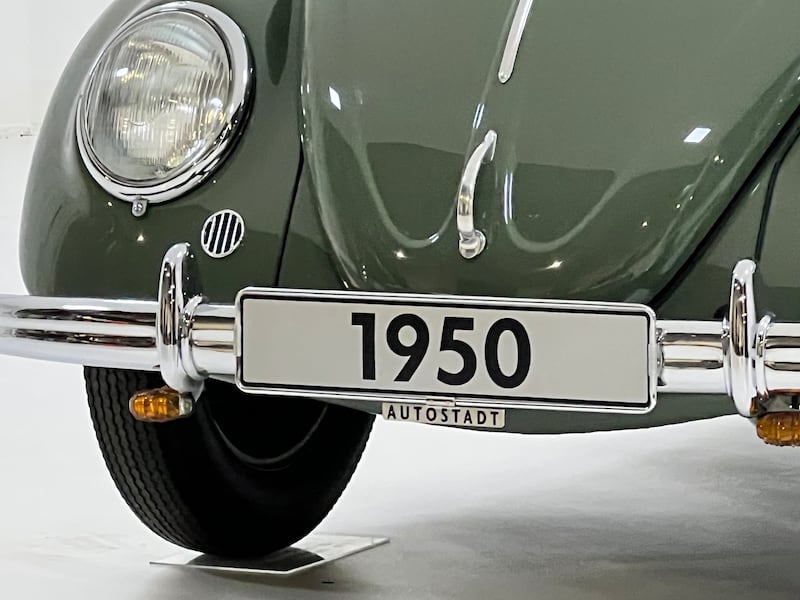It just doesn’t seem big enough to be so epochal. It’s small, green, curved almost like a worn-smooth pebble, and has that traditional friendly expression with its big, round headlights acting as proxies for eyes. It is, unmistakably, a Volkswagen Beetle.
It’s a bit of a special one though. You might wonder how any Beetle — one of 22 million made between 1945 and 2003 — could be considered special. Surely the sheer weight of numbers makes banal even that which is most interesting? Well, maybe not. This one has a special interest, all the more so seeing as its coming up to St Patrick’s Day…
This Beetle was built in Dublin. That is, perhaps, not so unusual as Ireland used to have a thriving car-making (strictly speaking car-assembling) industry. Ford is probably the company most well-known for having had a factory in Cork, but others — including Toyota, Fiat, Austin, Morris, Hillman, Mazda, Mercedes, and even Studebaker made cars in Ireland at one time or another.
This Beetle, however, really is special. It was the first one made outside of Germany, and very likely the first one made with right-hand drive. Eventually, the Beetle would be made more or less all over the world, most famously in a vast plant in Puebla, Mexico which kept the original ‘Type 1′ in production long after it was obsolete. For international Beetles, though, this little green one is Genesis.
‘In Turkey, on public transport, you should be very quiet. I was shocked by the behaviour in Ireland’
Mark Paul: Westminster never forgets its murdered MPs - which is why Kneecap’s comments could not be overlooked
Want an airport upgrade? Getting business class seats or valet parking doesn’t have to break the bank
Look inside: Extended Peter Pan-inspired four-bed in Delgany for €1.15m

It was the brainchild of Stephen O’Flaherty, who established Motor Distributors Limited as an importer for Volkswagen. The company is still going, and still owned by the O’Flaherty family. These days it is the Mercedes distributor for Ireland, and is about to take on a franchise for giant Chinese brand BYD, but back then it was a far simpler operation, located in an old tram shed on the Shelbourne Road in Dublin. Now, the site is home to the vast Ballsbridge Motors dealership and swanky offices, but in 1950 the road rang to the sounds of Beetles being made.
Not that many at first. An initial batch of of six Beetles from ‘CKD’ kits (Completely Knocked Down — effectively a flat-pack car and engine dispatched from Germany) had to be made and then sent back to VW’s HQ in Wolfsburg for inspection, to prove that O’Flaherty’s team was able to make the cars to the right quality levels.
That test passed, kits to make 46 cars were sent to Dublin, and O’Flaherty got to work. Larry Mooney was among those making early Beetles. He would eventually become the head of marketing and PR for Volkswagen in Ireland, and sadly passed away just recently. Before his passing, VW Ireland arranged for me to have a chat with him about the early days of making Beetles.
“I wasn’t quite there in the factory on the Shelbourne Road on day one, but almost. My father was a schoolteacher, and he as keen for me to do engineering, but I was always a car nut. So he got very upset because I was so keen on cars and somewhat blinkered. But my mother met Stephen O’Flaherty and had a word with him on my behalf and thats how I got started with Volkswagen in Ireland” said Mooney.

“O’Flaherty couldn’t stand someone being idle or standing still. So he got the assembly manager to come and interview me – I was only 14, but they went back and reported that I knew a lot about cars and was very keen, so I was appointed as an apprentice mechanic. But then I was put into the factory assembling Beetles for six months. So I knew where every nut, bolt and cable was on the Beetle before I went into the service department. The trouble was that I was now 15 and keen and the 40-year-olds in the service department didn’t fancy being told about the cars by me. The attitude was ‘will you ever go away you little red-headed b******…’
“Basically there was no German involvement in the operation aside from maybe one or two people. The cars came in in boxes, which were examined by customs at the docks, before being picked up and brought to the Shelbourne road. You won’t believe it but one of those customs inspectors was actually Ronnie Delaney, who went on to win Olympic gold for Ireland in Melbourne in 1956.
“No two Beetles were the same then, which I think was because they were actually built by individual people. Hand made effectively. I think cars have a human dimension to them.”
You’d certainly think so looking at the original Ballsbridge Beetle today. It’s regularly an exhibit in Volkswagen’s vast Autostadt museum, adjacent to the original factory in Wolfsburg, and it’s been pulled out of temporary storage so that we can finally meet. This meeting should have happened in 2020, on the 70th anniversary of the car being built, but obviously there were reasons why that didn’t happen… Still, it looks as spry at 73 as it did at 70, with only very small modifications having been made to keep it road legal, such as fitting proper indicators to supplement the little flip-out semaphore signals.

Finished in a fetching shade of almond green, the little Beetle exudes a cheerfulness extinct in most modern cars. Unlike a modern SUV, which generally glowers at you as if it wants to kill you, the Beetle looks as if it would come to heel if called. Inside, there is warmly tactile Bakelite plastic, finished in an ivory shade, and soft fabric seats — Beetles wouldn’t get harder-wearing vinyl for some years.
You can tell this is a very early model thanks to the oval rear window, with its distinctive dividing spine, and the ‘pope’s nose’ rear numberplate light, which does indeed look like a papal proboscis. Underneath the rear cover is the famed 1,100cc flat-four, air-cooled engine which in this form developed a mere 25hp. Still, that was enough — thanks to an aerodynamic body shape which produces a surprisingly competitive, in modern terms, drag coefficient of just 0.38Cd — for a 100km/h top speed.
For all the dinky power output, you could win rallies in a Beetle. The late Paddy Hopkirk started his rallying career, winning multiple Circuit of Ireland events in barely-modified Beetles which didn’t have a performance advantage, but which could be driven harder for longer than the competition.

Larry Mooney confirmed that it was the Beetle’s legendary reliability that gave it a leg-up in the Irish market. “Much of that was down to reliability. All other cars back then would have to have the valves done every 10,000 miles but the Beetle didn’t. Engines would be replaced at about 30,000 miles if you had a Ford or Austin or Morris. But the Beetle could do 60,000 miles. They had Bosch electrics which were brilliant, so simple little things like the distributors and condensers didn’t give trouble.”
It was that dependability that arguably made people warm to the Beetle, which wasn’t necessarily a given just five years on from the most destructive war in history. It’s a curious historical wrinkle that a car designed at the behest of the most evil regime ever to rule a country became an icon of counter-culture and the hippy movement. Larry Mooney reckoned that in 1950 Irish buyers were just more open-minded than most when it came to forgiving and forgetting. “It was funny at the time that two people who were approached to go into partnership with building and importing Volkswagens turned it down flat – they said that no-one would ever buy a German car” he told me.
“Irish people are very open though, and it was seen as what it was meant to be – the people’s car – and it just took off. We had very good people working with VW then though, very good managers, very good sales people. People in uniform were very good customers of ours back then too. Police, bus drivers, even priests if we can say priests wear a uniform.”

Very good sales became incredible sales in short order. From those original 46 cars, O’Flaherty quickly drove Beetle sales past the 2,000 mark in 1952 and it would go on to sell 3-4,000 every year through the fifties and sixties. So successful was the Beetle — priced in 1950 at £465 when the average Irish wage was just 2-shillings an hour — that questions were asked in the Dáil about how much Beetle sales were tipping the Government’s balance of payments.
By 1972 it was all over, and although the Beetle found a record 5,000 homes in Ireland that year, the writing was on the wall. VW had gone almost bankrupt keeping the Beetle in production beyond its shelf life, but the company was about to transform again with the launch of the Golf in 1974. From there, it would go on to become one of the three biggest car makers in the world, making as many as 10-million cars in a year, and taking control of such storied brands as Audi, Skoda, Bugatti, Seat, Bentley, and Lamborghini.
Such thoughts would surely not even have occurred to those cracking open 46 crates on the Shelbourne Road in 1950. Even so, the small green car that emerged was part of the building of a vast empire. You just wouldn’t credit it to one so small.















